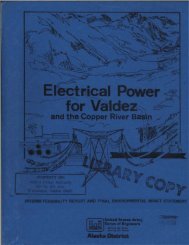Before the FERC Application for New License for the Annex Creek ...
Before the FERC Application for New License for the Annex Creek ...
Before the FERC Application for New License for the Annex Creek ...
Create successful ePaper yourself
Turn your PDF publications into a flip-book with our unique Google optimized e-Paper software.
United States Department of <strong>the</strong> Interior<br />
IN REPLY REi=E:M TO:<br />
~. i "',"J -<br />
• • ~ ! ,.:<br />
~'.'\J ~~ ,:~ 1'~:;5;.A<br />
~;',:t:.:n. 'W!mlt<br />
Sara Hunt<br />
400 Willoughby Avenue<br />
Suite 400<br />
Juneau, Alaska 99801<br />
FISH AND \VILDLIFE SERVIC=:<br />
p.o. Box 1287<br />
Juneau, Alaska 99802<br />
May 22, 1985<br />
Re: ADL 51675<br />
Certification No. 611<br />
Salmon <strong>Creek</strong><br />
Dear Ms. Hunt:<br />
We have reviewed your request <strong>for</strong> comments on <strong>the</strong> Alaska Electric Light and<br />
Power Company's (AEL&P) application <strong>for</strong> a chanqe of appropriation of water.<br />
The U.S. Fish and Wildlife Service (FWS) has met with Dave Hoopes of R.W. Beck<br />
and Associates, Inc., representing AEL&P in <strong>the</strong> relicensing coordination <strong>for</strong><br />
<strong>the</strong> Salmon <strong>Creek</strong> hydroelectric project. Mr. Hoopes has worked closely with<br />
<strong>the</strong> Alaska Department of Fish and Game (ADFG) in establishing a minimum<br />
acceptable flow <strong>for</strong> <strong>the</strong> creek.<br />
On April 29, 1985, biologists from <strong>the</strong> FWS and The National Marine Fisheries<br />
Service walked <strong>the</strong> lower portion of <strong>the</strong> creek up to <strong>the</strong> staff gauge. The<br />
staff gauge indicated a water depth of 1.5 feet. The staff gauge was in poor<br />
condition, but did not appear unstable. At a depth of 1.5 feet, all areas<br />
that we exaJnined which appeared to be of potential importance to anadromous<br />
fish were floooed. Previous field work by <strong>the</strong> Division of Commercial<br />
Fisheri.es indicates that <strong>the</strong> recorded low flows of 1985, corresponding to 1.4<br />
feet at <strong>the</strong> staff guage, were sufficient to protect all documented s-pawning<br />
habitat within accessible portions of <strong>the</strong> creek. Although this figure<br />
reflects a very low flow <strong>for</strong> this creek, we will concur with ADFG.<br />
Because changes in channel contours and elevations of natural drainages occur<br />
over time, we believe it is necessary to correlate <strong>the</strong> minimum acceptable<br />
depth with a value in cubic feet per second (cfs). He understand that AEL&P<br />
has obtained a range <strong>for</strong> this value using discharge data from <strong>the</strong> u.s.<br />
Geological Survey. The amount of discharge at 1.4 feet depth varies between 7<br />
and 9 cfs. Because of this variability and because of our concern that<br />
spawning beds remain inundated throughout <strong>the</strong> winter, it is appropriate that<br />
<strong>the</strong> higher figure serve as <strong>the</strong> standard. Should <strong>the</strong>re be changes in <strong>the</strong><br />
course or contour of <strong>the</strong> stream, a new staging gauge value should be selected<br />
which corresponds to a discharge of approximately 9 cfs.<br />
Of additional concern is <strong>the</strong> national record of fish loss which results when<br />
flow levels are not adequately monitored. Monitoring is absolutely critical<br />
if minimum flow standar.ds are to have any value. Monitor.ing and proper<br />
regulation must also insure that excessive water is not dumped from <strong>the</strong> Salmon<br />
<strong>Creek</strong> Dam.

















